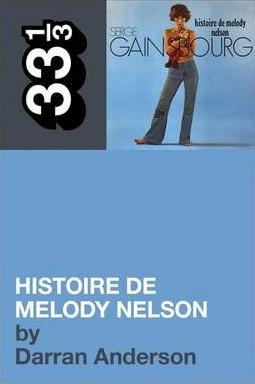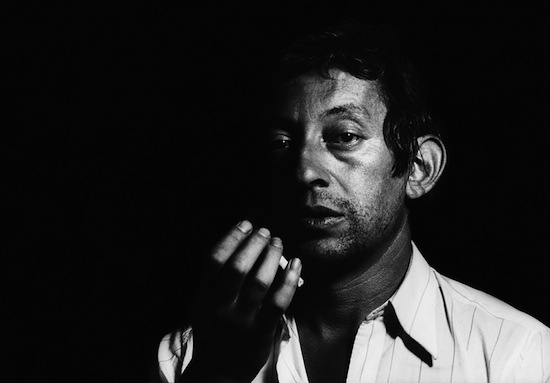If it’s pictures you’re after – especially of a photogenic and achingly cool couple caught forever in time at the end of the 60s and the start of the 1970s – then there are plenty of books out there, including Andrew Birkin’s Jane & Serge, a new publication full of intimate black and white snaps presented in an alluring coffee table book just in time for Christmas for the Elle reader in your life. They reinforce what we already know, that Serge Gainsbourg was a lover, a joker, a smoker and a procurer of beautiful young women. And then there are the other two facts that everyone thinks they know about him, that ‘Je t’aime (mon non plus)’ was so scandalous that even the Vatican banned it, and that he once asked Whitney Houston to fuck him on live TV. Both true.
If these are to be his legacy outside of France then the late, great, chanteur, songwriter, musician, poète maudit, svengali, actor and provocateur has nobody to blame but himself. He once famously said, "for me provocation is oxygen", and for some it is the only aspect of a multifarious and complex artist that they really know about.
The cult of Melody Nelson is ever expanding though, a record so often chanced upon which in so many instances invokes in the listener a feeling that they’ve stumbled upon the Gallic holy grail, an LP that only sold 20,000 on its initial release and has since slow burned its way to legend.
The cult of Melody Nelson is ever-expanding, though, a record so often chanced upon which in so many instances invokes in the listener a feeling that they’ve stumbled upon the Gallic holy grail, an LP that only sold 20,000 on its initial release and has since slow burned its way to legend. Despite this stealthy canonisation, there are fewer books about Gainsbourg written in the English language than you might think, and none until now specifically deals with Histoire de Melody Nelson. There’s Sylvie Simmons’ excellent A Fist Full of Gitanes, which whips through Gainsbourg’s life swiftly and chronologically, often seen through the eyes of Jane Birkin – the main interviewee, and Alan Clayson’s A View From The Exterior, which I’ll confess I haven’t read just yet. And now 33⅓ have turned their attentions to Gainsbourg’s chef d’oeuvre (with more than a little help from Birkin as well as the transcendentally gifted Jean Claude Vannier, an orchestral writer and arranger whose only just beginning to get his dues).
"It had to bomb commercially to achieve the more intriguing afterlife as a cult album," says Anderson in the book, "one you had to search through crates to find, that was spoken of in reverential whispers, that was passed on to friends with the knowledge that you will never see this record again…" In my own experience this last fact is true, and I now own a vinyl copy with its own padlock.
If Simmonds’ aforementioned account deals mainly in events then Anderson’s book takes us on an odyssey of well thought out and researched supposition. Birkin wasn’t available to talk for whatever reason, and actually that’s probably a blessing in disguise – one that makes this the perfect companion to Simmonds’ endeavour. Without the restraints of fitting into the parameters of eye witness accounts and incident, Anderson is free to roam. And roam he does with much whimsy and with wonderful turns of phrase, meandering sometimes with purpose and at others appearing to digress, with distinction down corridors of dialectics and discernment. What it lacks in length it makes up for in detail, which feels entirely appropriate given we’re concerned with a record that only lasts 29 minutes but oozes ideas.
The seven songs of the record are covered over seven chapters, though we find ourselves just as easily talking about ‘Le Poinçonneur des Lilas’ (Gainsbourg’s first moment of genius, of which Anderson writes that it is "the closest pop music has ever got to Existentialism, being more Beckett than Bacharach") to his latter day cover of ‘Szomorú vasárnap’ (or ‘Gloomy Sunday’) – a legendary funereal-folk song eventually banned by the Hungarian government because it supposedly drove listeners to suicide) than we do the songs in question.
The lack of any self-imposed structure or a need for forensic detail surrounding the logistics of songs etc mean that Anderson is free to delve into some of the more interesting aspects of the person and the formative influences on Gainsbourg, seen and unseen. His love of Fantômas and André Breton and later Nabokov, his relationship with his mentor – the polymath Boris Vian who wrote L’ecume des jours among many other things, and most invidiously the effect the German occupation of Paris had on the teenage Lucien Ginsburg – his first identity. A Jew with Russian immigrants parents, Gainsbourg was forced to report to the Nazis and wear the yellow Star of David, and these experiences would undoubtedly shape the man.
The issue of Melody Nelson, of exactly how old she’s supposed to be, along with perennial claims of Gainsbourg’s misogyny are also dealt with here thoroughly and head on and in a refreshingly adult manner. There are no declarations or decisions, just discourse. Gainsbourg might have been a provocateur but this book pitches him as a protean figure sucking up influences and part of a lineage that stretches way back to Rimbaud and Verlaine, through the Surrealists and the Dadaists (Gainsbourg was a painter first), to the Situationists (about whom he was sniffy) and the Punks (who respected the old goat). He was a singer who unfairly suffered derision from the press for his looks for many years, though he weathered the brickbats and had the last laugh, becoming part of a beautiful couple we’re supposedly still obsessed with forty-or-so years on. Those pictures recently uncovered are gorgeous and enchanting, but if you want to go a little further, Anderson’s book burrows deep under the skin.

Darran Anderson’s Histoire de Melody Nelson is published December 19th by 33 1/3


